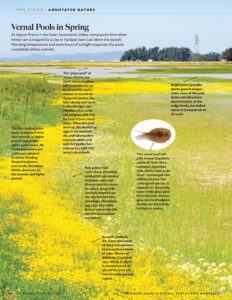At the precise moment we are looking at them, flowers are sending light rays back to us. But not all of them are sending us the same kind of light in the same way. The different colors are different wavelengths of light. The ultimate source of all of this light is the sun, whose light contains a mixture of many different wavelengths. The parts of some flowers contain molecules that absorb some of the wavelengths and reflect others, much as paints do. There are many different kinds of these molecules, known as floral pigments, and they occur in complex mixtures.
Not all of the color we see is the result of the floral pigments. The cell structure of flower parts can produce or modify colors, like a piece of transparent glass. In the simplest situation, the cells can reflect all incoming light, producing a brilliant white. But they can also act as little prisms, bending the sun’s rays so that different colors are seen at different angles. Combinations of floral pigments and cellular structure give us both a great range of colors and gradations in those colors that may be dull, glossy, or of truly fiery intensity.
Humans have long been captivated by the visual appearance of flowers, but their colors did not evolve to please us. Rather, through millions of years, flowers have been perfecting their colors to attract the animals that pollinate them. The colors, including some that humans cannot see, thus match the receptive ranges of the eyes of the pollinating animals. Red flowers, such as paintbrushes and California fuchsia, generally attract butterflies and hummingbirds. Yellows and blues, as in poppies and lupines, tend to be more attractive to bees. White flowers have the best visibility in low light, such as at night or in forest understories, and are thus best suited to pollinators active in those situations, such as hawk-moths and flies.
A special feature of California landscapes is the occurrence of great expanses of flowers of the same species. The biological significance of these massive color displays is now being actively investigated. It is probably no coincidence that California is the world center of biodiversity for solitary bees. Members of each of these species of bee must find large amounts of nectar and pollen within a separate and relatively short period of the year, unlike honeybees, which develop large colonies that use a wide variety of flowers over many months. Here in California it is possible to rely on large numbers of blossoms all opening in synchrony in the accustomed places year after year. How fortunate for the bees … and for the humans!




